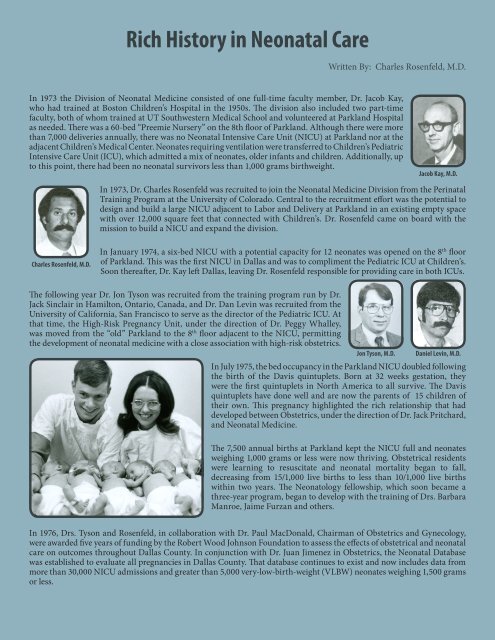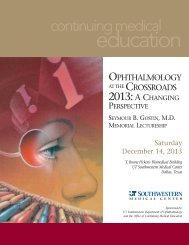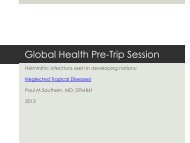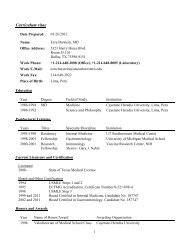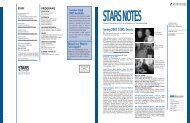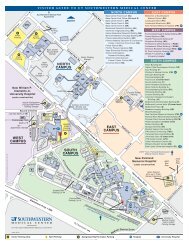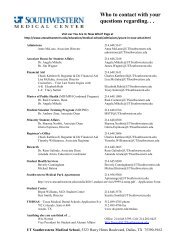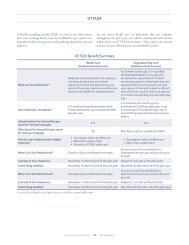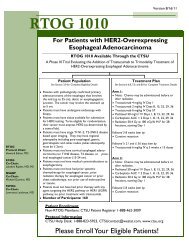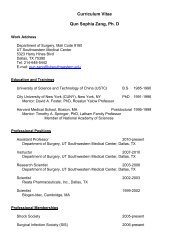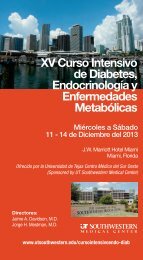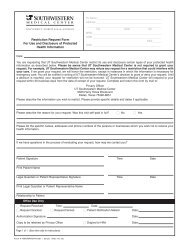Rich History in Neonatal Care - UT Southwestern
Rich History in Neonatal Care - UT Southwestern
Rich History in Neonatal Care - UT Southwestern
You also want an ePaper? Increase the reach of your titles
YUMPU automatically turns print PDFs into web optimized ePapers that Google loves.
<strong>Rich</strong> <strong>History</strong> <strong>in</strong> <strong>Neonatal</strong> <strong>Care</strong><br />
Written By: Charles Rosenfeld, M.D.<br />
In 1973 the Division of <strong>Neonatal</strong> Medic<strong>in</strong>e consisted of one full-time faculty member, Dr. Jacob Kay,<br />
who had tra<strong>in</strong>ed at Boston Children’s Hospital <strong>in</strong> the 1950s. The division also <strong>in</strong>cluded two part-time<br />
faculty, both of whom tra<strong>in</strong>ed at <strong>UT</strong> <strong>Southwestern</strong> Medical School and volunteered at Parkland Hospital<br />
as needed. There was a 60-bed “Preemie Nursery” on the 8th floor of Parkland. Although there were more<br />
than 7,000 deliveries annually, there was no <strong>Neonatal</strong> Intensive <strong>Care</strong> Unit (NICU) at Parkland nor at the<br />
adjacent Children’s Medical Center. Neonates requir<strong>in</strong>g ventilation were transferred to Children’s Pediatric<br />
Intensive <strong>Care</strong> Unit (ICU), which admitted a mix of neonates, older <strong>in</strong>fants and children. Additionally, up<br />
to this po<strong>in</strong>t, there had been no neonatal survivors less than 1,000 grams birthweight.<br />
Jacob Kay, M.D.<br />
In 1973, Dr. Charles Rosenfeld was recruited to jo<strong>in</strong> the <strong>Neonatal</strong> Medic<strong>in</strong>e Division from the Per<strong>in</strong>atal<br />
Tra<strong>in</strong><strong>in</strong>g Program at the University of Colorado. Central to the recruitment effort was the potential to<br />
design and build a large NICU adjacent to Labor and Delivery at Parkland <strong>in</strong> an exist<strong>in</strong>g empty space<br />
with over 12,000 square feet that connected with Children’s. Dr. Rosenfeld came on board with the<br />
mission to build a NICU and expand the division.<br />
Charles Rosenfeld, M.D.<br />
In January 1974, a six-bed NICU with a potential capacity for 12 neonates was opened on the 8 th floor<br />
of Parkland. This was the first NICU <strong>in</strong> Dallas and was to compliment the Pediatric ICU at Children’s.<br />
Soon thereafter, Dr. Kay left Dallas, leav<strong>in</strong>g Dr. Rosenfeld responsible for provid<strong>in</strong>g care <strong>in</strong> both ICUs.<br />
The follow<strong>in</strong>g year Dr. Jon Tyson was recruited from the tra<strong>in</strong><strong>in</strong>g program run by Dr.<br />
Jack S<strong>in</strong>clair <strong>in</strong> Hamilton, Ontario, Canada, and Dr. Dan Lev<strong>in</strong> was recruited from the<br />
University of California, San Francisco to serve as the director of the Pediatric ICU. At<br />
that time, the High-Risk Pregnancy Unit, under the direction of Dr. Peggy Whalley,<br />
was moved from the “old” Parkland to the 8 th floor adjacent to the NICU, permitt<strong>in</strong>g<br />
the development of neonatal medic<strong>in</strong>e with a close association with high-risk obstetrics.<br />
Jon Tyson, M.D.<br />
Daniel Lev<strong>in</strong>, M.D.<br />
In July 1975, the bed occupancy <strong>in</strong> the Parkland NICU doubled follow<strong>in</strong>g<br />
the birth of the Davis qu<strong>in</strong>tuplets. Born at 32 weeks gestation, they<br />
were the first qu<strong>in</strong>tuplets <strong>in</strong> North America to all survive. The Davis<br />
qu<strong>in</strong>tuplets have done well and are now the parents of 15 children of<br />
their own. This pregnancy highlighted the rich relationship that had<br />
developed between Obstetrics, under the direction of Dr. Jack Pritchard,<br />
and <strong>Neonatal</strong> Medic<strong>in</strong>e.<br />
The 7,500 annual births at Parkland kept the NICU full and neonates<br />
weigh<strong>in</strong>g 1,000 grams or less were now thriv<strong>in</strong>g. Obstetrical residents<br />
were learn<strong>in</strong>g to resuscitate and neonatal mortality began to fall,<br />
decreas<strong>in</strong>g from 15/1,000 live births to less than 10/1,000 live births<br />
with<strong>in</strong> two years. The Neonatology fellowship, which soon became a<br />
three-year program, began to develop with the tra<strong>in</strong><strong>in</strong>g of Drs. Barbara<br />
Manroe, Jaime Furzan and others.<br />
In 1976, Drs. Tyson and Rosenfeld, <strong>in</strong> collaboration with Dr. Paul MacDonald, Chairman of Obstetrics and Gynecology,<br />
were awarded five years of fund<strong>in</strong>g by the Robert Wood Johnson Foundation to assess the effects of obstetrical and neonatal<br />
care on outcomes throughout Dallas County. In conjunction with Dr. Juan Jimenez <strong>in</strong> Obstetrics, the <strong>Neonatal</strong> Database<br />
was established to evaluate all pregnancies <strong>in</strong> Dallas County. That database cont<strong>in</strong>ues to exist and now <strong>in</strong>cludes data from<br />
more than 30,000 NICU admissions and greater than 5,000 very-low-birth-weight (VLBW) neonates weigh<strong>in</strong>g 1,500 grams<br />
or less.
Additional faculty were soon recruited from prestigious <strong>in</strong>stitutions,<br />
<strong>in</strong>clud<strong>in</strong>g Dr. Bill Engle from Children’s Hospital of Philadelpia <strong>in</strong><br />
1980, Dr. Abbot Laptook from Brown University <strong>in</strong> 1981 and Dr.<br />
Heber Nielsen from Harvard, also <strong>in</strong> 1981. The division’s research base<br />
expanded to <strong>in</strong>clude studies of cerebral blood flow and metabolism,<br />
renal physiology and surfactant synthesis. The division also was asked<br />
to collaborate <strong>in</strong> the first large scale assessment of bronchopulmonar<br />
dysplasia (BPD) by the National Institutes of Health (NIH).<br />
Bill Engle, M.D.<br />
Abbot Laptook, M.D.<br />
Heber Nielsen, M.D.<br />
With the Parkland NICU now at full capacity and no NICU at Children’s, there was an <strong>in</strong>creas<strong>in</strong>g lack of bed space. The<br />
Pediatric Burn Unit was moved from the 8 th floor at Parkland, creat<strong>in</strong>g room for the expanded <strong>in</strong>tensive care area of the<br />
NICU with 15 beds. The older NICU area became the step-down or <strong>in</strong>termediate care area. This resulted <strong>in</strong> 27 ICU beds to<br />
cover the more than 8,000 births and approximately 1,000 NICU admissions occurr<strong>in</strong>g annually.<br />
The Hospital District and County Commissioners soon realized that Parkland needed to be updated and the NICU needed<br />
to expand and move to the space adjacent to Labor and Delivery. In 1980, with the efforts of Ralph Rogers, Chairman of the<br />
Hospital Board, and many others, an $80 million bond issue was passed by the people of Dallas to modernize Parkland and<br />
build a new NICU. When the new NICU opened <strong>in</strong> 1984, neonates were successfully transported down five floors to a large,<br />
modern NICU located less than 50 feet from Labor and Delivery. The new NICU was eqipped with 15-20 ICU beds and 40<br />
ACN/CCN beds to accommodate the <strong>in</strong>crease <strong>in</strong> deliveries to 11,000 annually.<br />
From 1985 to 1988 the division welcomed eight new faculty members from academic <strong>in</strong>stitutions across the nation. Included<br />
<strong>in</strong> the new faculty was a developmental psychologist, Dr. Bob Lasky, who was recruited to run the Low Birth Weight Followup<br />
Cl<strong>in</strong>ic, to <strong>in</strong>itiate research <strong>in</strong> auditory evoke potentials, and to permit the division to collaborate successfully with Dr.<br />
Marie McCormic at Harvard on a nationwide study of early <strong>in</strong>tervetion <strong>in</strong> VLBW neonates.<br />
The fellowship Program grew to two to three tra<strong>in</strong>ees each year, and the teach<strong>in</strong>g and research efforts of<br />
the division were thriv<strong>in</strong>g <strong>in</strong> the 1980s. Through the efforts of Dr. Jon Tyson, the division was selected as a<br />
found<strong>in</strong>g <strong>in</strong>stitution <strong>in</strong> the development of the NIH-sponsored <strong>Neonatal</strong> Network for Cl<strong>in</strong>ical Trials <strong>in</strong> 1986.<br />
It has s<strong>in</strong>ce rema<strong>in</strong>ed an important player <strong>in</strong> the network, reflect<strong>in</strong>g successful efforts to recruit patients<br />
and by ma<strong>in</strong>ta<strong>in</strong><strong>in</strong>g an outstand<strong>in</strong>g follow-up program run by Dr. Sue Broyles from 1991 through 2002<br />
and Dr. Roy Heyne s<strong>in</strong>ce 2003. The follow-up program was nationally recongized as the first randomized<br />
controlled trial to report that primary care offered a significant advantage to the outcome of VLBW neonates.<br />
In the 1990s, the NICU at Parkland was chosen by the Hospital Adm<strong>in</strong>istration as one of seven Centers of<br />
Excellence.<br />
The cl<strong>in</strong>ical, research and teach<strong>in</strong>g programs were further strengthened with the recruitment of Dr. Jeff<br />
Perlman from Wash<strong>in</strong>gton University, Dr. Fernando Moya from Yale, Dr. Philip Shaul from Brown and Drs.<br />
Pablo Sanchez, Blair Cox, Myra Wyckoff and Walid Salhab from <strong>UT</strong> <strong>Southwestern</strong> between 1990 and 2000.<br />
Sue Broyles, M.D.<br />
Roy Heyne, M.D.<br />
Dr. Greg Jackson was recruited <strong>in</strong> 1989 to direct the division’s teach<strong>in</strong>g and cl<strong>in</strong>ical program <strong>in</strong> the term nursery and to<br />
develop the Pediatric Nurse Practitioner Program and was jo<strong>in</strong>ed by Dr. Dorothy Sendelbach <strong>in</strong> 1993. At present there are<br />
seven general pediatricians <strong>in</strong> the division who teach, do cl<strong>in</strong>ical research and both supervise and provide care to nearly<br />
15,000 near-term and term neonates annually. This group has added to the scholarly activities of the division and has<br />
excelled <strong>in</strong> teach<strong>in</strong>g.<br />
Jeffrey Perlman, M.D.<br />
Philip Shaul, M.D.<br />
Pablo Sanchez, M.D. Blair Cox, M.D.<br />
Myra Wyckoff, M.D.<br />
Walid Salhab, M.D. Greg Jackson, M.D. Dorothy Sendelbach, M.D.
In 1981, the Obstetrics and Pediatric staff at St. Paul Hospital approached the division to consider start<strong>in</strong>g a NICU and<br />
assum<strong>in</strong>g care of their high-risk patients. This provided an opportunity to develop a referral program for women with<br />
high-risk pregnancies and neonates on the campus and to <strong>in</strong>corporate the cl<strong>in</strong>ical expertise available at St. Paul to deliver<br />
c to these patients. An educational outreach program was developed expand<strong>in</strong>g the referral base for neonates and at-risk<br />
pregnant women to <strong>in</strong>clude areas of north and east Texas. Dr. Jon Tyson was the first Medical Director of the outreach<br />
program and was succeeded by Dr. Kathleen Kennedy. St. Paul served as an excellent tra<strong>in</strong><strong>in</strong>g experience for the pediatric<br />
residents until Texas Health Resources purchased the it <strong>in</strong> 2000.<br />
Although the new Parkland NICU was designed to accommodate neonates from approximately 12,000 deliveries annually,<br />
it has s<strong>in</strong>ce required renovation and expansion to address the cont<strong>in</strong>u<strong>in</strong>g <strong>in</strong>crease <strong>in</strong> deliveries. There are presently more<br />
than 15,000 births per year and approximately 1,300 admissions to the Level III NICU, mak<strong>in</strong>g it one of the busiest <strong>in</strong> the<br />
nation.<br />
Efforts began <strong>in</strong> 2000 to establish a referral NICU at Children’s, and <strong>in</strong> April 2007 a temporary<br />
16-bed NICU was opened. In 2009, a permanent expansion to a 36-bed referral NICU occurred,<br />
allow<strong>in</strong>g the Children’s NICU to become a major site for neonatal referrals <strong>in</strong> the area.<br />
Recruitment efforts cont<strong>in</strong>ue <strong>in</strong> order to provide excellence <strong>in</strong> research, tra<strong>in</strong><strong>in</strong>g, cl<strong>in</strong>ical care<br />
and long-term follow-up for high-risk pregnant women and neonates <strong>in</strong> North Texas.<br />
Dr. Rashm<strong>in</strong> Savani jo<strong>in</strong>ed the division <strong>in</strong> March 2006<br />
and became the Division Director when Dr. Rosenfeld<br />
stepped down <strong>in</strong> January 2007. Dur<strong>in</strong>g Dr. Rosenfeld’s 34<br />
years as Director there were more than 250,000 births and<br />
Charles R. Rosenfeld, M.D.<br />
nearly 30,000 NICU admissions at Parkland. The fellowship<br />
program, now under the direction of Dr. Luc Brion, has tra<strong>in</strong>ed at least 60 fellows <strong>in</strong><br />
<strong>Neonatal</strong>-Per<strong>in</strong>atal Medic<strong>in</strong>e, many of whom have pursued academic careers.<br />
Rashm<strong>in</strong> Savani, M.B.Ch.B.<br />
In 2010 the division totaled 24 faculty and 12 fellows. Several faculty members have moved<br />
to become Directors of other divisions or successful <strong>in</strong>vestigators at their respective<br />
<strong>in</strong>stitutions. All of this exemplifies the extra ord<strong>in</strong>ary group of faculty assembled by<br />
the division over time, their collaborative nature and their cont<strong>in</strong>ued commitment to<br />
excellence.


